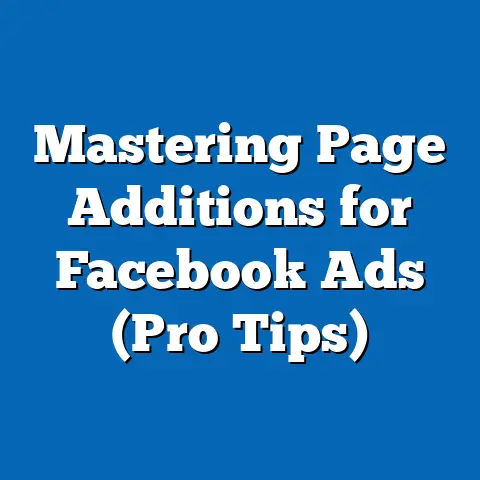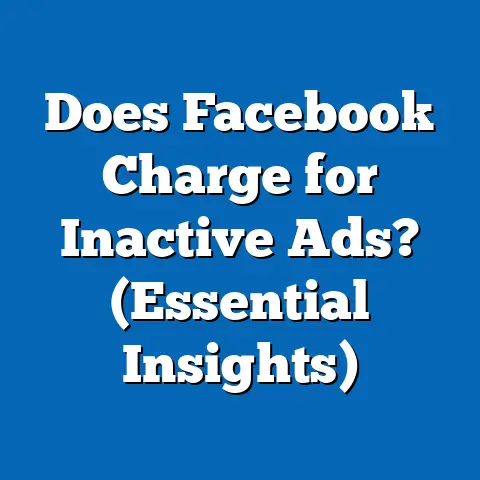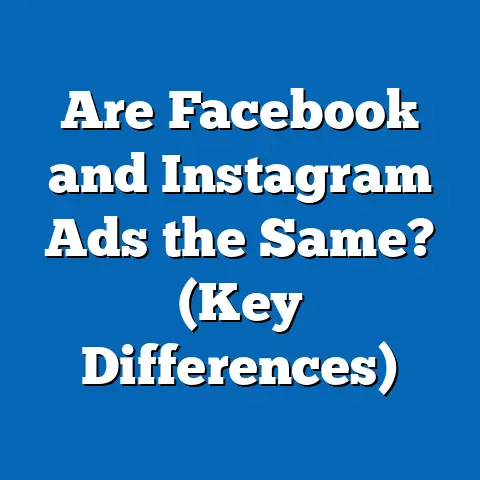Do Facebook Ads Need Approval for Placement Changes? (Key Insights)
In the ever-evolving world of digital marketing, Facebook Ads remain a cornerstone for businesses seeking to reach a vast and targeted audience. As advertisers, we’re constantly striving to optimize our campaigns for maximum impact, often tweaking various elements, including ad placements. But here’s a question that often pops up and causes a bit of anxiety: Do Facebook Ads need approval for placement changes?
Imagine this: You’ve meticulously crafted an ad campaign, targeting the perfect demographic with compelling visuals and persuasive copy. You launch it, and initially, the results are promising. However, after a week, you notice that some placements are underperforming while others are exceeding expectations. Naturally, you want to shift your budget and focus on the winning placements. But wait – will these changes trigger another round of approvals, potentially halting your momentum and disrupting your entire strategy?
This is a critical question because a sudden pause in your campaign can impact visibility, budget allocation, and overall ad effectiveness. Understanding the intricacies of Facebook’s ad approval process, especially as it relates to placement changes, is an essential skill for any marketer aiming to optimize campaigns and achieve desired results.
Understanding Facebook Ad Placement
Before we delve into the approval process, let’s first define what Facebook ad placements actually are. Simply put, ad placements refer to the specific locations on Facebook and its associated platforms where your ads can appear. These placements vary significantly in terms of their visual presentation, user context, and engagement potential. Choosing the right placements is crucial for reaching your target audience effectively and maximizing your return on investment.
Here are some of the most common Facebook ad placement options:
-
Facebook Feed: This is the most recognizable placement, where ads appear directly within users’ news feeds, alongside posts from friends, family, and pages they follow. Ads in the Facebook Feed are highly visible and can be very effective for driving awareness and engagement. I’ve personally found that using high-quality images and videos is key to capturing attention in this busy environment.
-
Instagram Feed: Similar to the Facebook Feed, ads in the Instagram Feed appear directly within users’ scrolling feed of photos and videos. Since Instagram is a visually-driven platform, this placement is ideal for showcasing visually appealing products or services. In my experience, lifestyle imagery and user-generated content tend to perform particularly well here.
-
Instagram Stories: These are full-screen vertical videos or images that disappear after 24 hours. Instagram Stories ads are engaging and immersive, making them a great choice for capturing attention and driving quick actions. I’ve had success using interactive elements like polls and quizzes in my Story ads to boost engagement.
-
Facebook Marketplace: This is a platform where users can buy and sell items locally. Ads in the Facebook Marketplace can reach users who are actively looking to purchase products, making it a valuable placement for e-commerce businesses. I’ve seen great results when targeting users based on their interests and purchase history in the Marketplace.
-
Facebook Watch: This is Facebook’s video-on-demand service. Ads in Facebook Watch appear before, during, or after videos, similar to TV commercials. This placement is ideal for reaching a large audience with video ads and building brand awareness.
-
Audience Network: This extends your ads beyond Facebook and Instagram to a network of third-party websites and apps. The Audience Network allows you to reach a broader audience and potentially lower your advertising costs. However, it’s important to monitor performance closely, as the quality of placements can vary.
Facebook Feed: This is the most recognizable placement, where ads appear directly within users’ news feeds, alongside posts from friends, family, and pages they follow. Ads in the Facebook Feed are highly visible and can be very effective for driving awareness and engagement. I’ve personally found that using high-quality images and videos is key to capturing attention in this busy environment.
Instagram Feed: Similar to the Facebook Feed, ads in the Instagram Feed appear directly within users’ scrolling feed of photos and videos. Since Instagram is a visually-driven platform, this placement is ideal for showcasing visually appealing products or services. In my experience, lifestyle imagery and user-generated content tend to perform particularly well here.
Instagram Stories: These are full-screen vertical videos or images that disappear after 24 hours. Instagram Stories ads are engaging and immersive, making them a great choice for capturing attention and driving quick actions. I’ve had success using interactive elements like polls and quizzes in my Story ads to boost engagement.
Facebook Marketplace: This is a platform where users can buy and sell items locally. Ads in the Facebook Marketplace can reach users who are actively looking to purchase products, making it a valuable placement for e-commerce businesses. I’ve seen great results when targeting users based on their interests and purchase history in the Marketplace.
Facebook Watch: This is Facebook’s video-on-demand service. Ads in Facebook Watch appear before, during, or after videos, similar to TV commercials. This placement is ideal for reaching a large audience with video ads and building brand awareness.
Audience Network: This extends your ads beyond Facebook and Instagram to a network of third-party websites and apps. The Audience Network allows you to reach a broader audience and potentially lower your advertising costs. However, it’s important to monitor performance closely, as the quality of placements can vary.
Why is choosing the right placement so important?
Well, think about it. You wouldn’t show a formal business suit to someone browsing funny cat videos, right? Different demographics and user behaviors are associated with each placement. For example, younger audiences tend to spend more time on Instagram Stories, while older demographics might be more active on the Facebook Feed.
According to recent statistics, mobile ad spending continues to dominate, with a significant portion allocated to social media platforms like Facebook and Instagram. This underscores the importance of optimizing your ads for mobile devices and selecting placements that are mobile-friendly.
Takeaway: Understanding the nuances of each Facebook ad placement is the first step towards creating effective campaigns. Consider your target audience, your ad creative, and your campaign goals when making your placement choices.
The Approval Process Explained
Now that we’ve covered ad placements, let’s dive into the Facebook ad approval process. This process is a crucial part of maintaining a positive and safe user experience on the platform, and it’s essential for advertisers to understand how it works.
Why does Facebook have an approval process?
Facebook implements an approval system for ads for several key reasons:
-
Quality Control: Facebook wants to ensure that the ads users see are relevant, high-quality, and don’t contain misleading or deceptive information. This helps to maintain user trust and prevent negative experiences.
-
Community Standards: Facebook has strict community standards that prohibit hate speech, violence, and other forms of harmful content. The ad approval process helps to prevent ads that violate these standards from being displayed on the platform.
-
Advertising Policies: Facebook has specific advertising policies that outline what types of products and services can be advertised, as well as the types of claims that can be made in ads. The approval process ensures that ads comply with these policies.
Quality Control: Facebook wants to ensure that the ads users see are relevant, high-quality, and don’t contain misleading or deceptive information. This helps to maintain user trust and prevent negative experiences.
Community Standards: Facebook has strict community standards that prohibit hate speech, violence, and other forms of harmful content. The ad approval process helps to prevent ads that violate these standards from being displayed on the platform.
Advertising Policies: Facebook has specific advertising policies that outline what types of products and services can be advertised, as well as the types of claims that can be made in ads. The approval process ensures that ads comply with these policies.
What criteria does Facebook use to evaluate ads?
Facebook uses a combination of automated systems and human reviewers to evaluate ads for approval. The criteria used to evaluate ads include:
-
Ad Content: This includes the text, images, videos, and other elements of the ad. Facebook looks for content that is accurate, relevant, and doesn’t violate any of its policies.
-
Landing Page: The landing page that users are directed to when they click on the ad is also evaluated. Facebook checks to ensure that the landing page is functional, relevant to the ad, and doesn’t contain any misleading or deceptive information.
-
Targeting: Facebook also considers the targeting options used for the ad. Ads that target sensitive demographics or promote discriminatory practices are likely to be disapproved.
-
Placement: As we’ll discuss in more detail later, the placement of the ad can also impact the approval process. Certain types of content may be more appropriate for some placements than others.
Ad Content: This includes the text, images, videos, and other elements of the ad. Facebook looks for content that is accurate, relevant, and doesn’t violate any of its policies.
Landing Page: The landing page that users are directed to when they click on the ad is also evaluated. Facebook checks to ensure that the landing page is functional, relevant to the ad, and doesn’t contain any misleading or deceptive information.
Targeting: Facebook also considers the targeting options used for the ad. Ads that target sensitive demographics or promote discriminatory practices are likely to be disapproved.
Placement: As we’ll discuss in more detail later, the placement of the ad can also impact the approval process. Certain types of content may be more appropriate for some placements than others.
What is the timeline for approval?
The timeline for ad approval can vary depending on several factors, including the complexity of the ad, the volume of ads being submitted, and the time of day. In general, most ads are reviewed within 24 hours, but some may take longer.
How can advertisers track their submission status?
Advertisers can track the status of their ad submissions in the Facebook Ads Manager. The Ads Manager provides real-time updates on the status of each ad, including whether it is pending review, approved, or disapproved.
My personal experience with the approval process:
I remember once launching a campaign for a local restaurant that featured mouthwatering images of their signature dishes. The ads were initially approved, but after a few days, one of the ads was suddenly disapproved. After some digging, I discovered that the issue was with the landing page, which had a broken link to the menu. This experience taught me the importance of thoroughly checking all aspects of your ad campaign, including the landing page, before submitting it for approval.
Takeaway: Understanding the Facebook ad approval process is crucial for avoiding delays and ensuring that your ads are displayed on the platform. Familiarize yourself with Facebook’s advertising policies and ensure that your ads comply with all requirements.
Do Placement Changes Require Approval?
Now we arrive at the heart of the matter: Do placement changes require approval? The answer, as with many things in the world of Facebook advertising, is… it depends.
In general, minor adjustments to ad placements usually do not trigger a new approval process. For example, if you’re running an ad campaign that includes both the Facebook Feed and the Instagram Feed, and you decide to pause the Instagram Feed placement, this change is unlikely to require a new review.
However, significant changes to ad placements may require a new approval. This is particularly true if the changes involve:
-
Adding a new placement that is significantly different from the original placements: For example, if you were initially running ads only on the Facebook Feed and Instagram Feed, and you decide to add the Audience Network, this change may trigger a new approval. The Audience Network has different content guidelines and ad formats than the Facebook and Instagram Feeds, so Facebook may want to ensure that your ad is appropriate for this new placement.
-
Switching to a placement that has stricter content guidelines: For example, if you were running ads on the Facebook Feed and you decide to switch to Instagram Stories, this change may require a new approval. Instagram Stories have stricter content guidelines than the Facebook Feed, particularly when it comes to promoting certain types of products or services.
-
Making changes to your ad creative that are specifically tailored to a new placement: For example, if you were running a square video ad on the Facebook Feed and you decide to create a vertical video ad specifically for Instagram Stories, this change may require a new approval. The new ad creative may need to be reviewed to ensure that it is appropriate for the Instagram Stories format and content guidelines.
Adding a new placement that is significantly different from the original placements: For example, if you were initially running ads only on the Facebook Feed and Instagram Feed, and you decide to add the Audience Network, this change may trigger a new approval. The Audience Network has different content guidelines and ad formats than the Facebook and Instagram Feeds, so Facebook may want to ensure that your ad is appropriate for this new placement.
Switching to a placement that has stricter content guidelines: For example, if you were running ads on the Facebook Feed and you decide to switch to Instagram Stories, this change may require a new approval. Instagram Stories have stricter content guidelines than the Facebook Feed, particularly when it comes to promoting certain types of products or services.
Making changes to your ad creative that are specifically tailored to a new placement: For example, if you were running a square video ad on the Facebook Feed and you decide to create a vertical video ad specifically for Instagram Stories, this change may require a new approval. The new ad creative may need to be reviewed to ensure that it is appropriate for the Instagram Stories format and content guidelines.
Here’s a scenario to illustrate this:
Let’s say you’re running a campaign to promote a new mobile game. Your initial ad creative features gameplay footage and a call-to-action to download the game. You’re running this ad on the Facebook Feed and Instagram Feed. After a few days, you decide to add the Audience Network to your campaign.
Since the Audience Network includes a wide range of websites and apps, Facebook may want to ensure that your ad is appropriate for this new placement. They may review your ad to ensure that it doesn’t contain any offensive or misleading content, and that it complies with the Audience Network’s content guidelines.
How can you tell if a placement change will require approval?
Unfortunately, there’s no foolproof way to know for sure whether a placement change will require approval. However, here are some general guidelines:
- If you’re making minor adjustments to existing placements, it’s unlikely to require approval.
- If you’re adding a new placement that is significantly different from your existing placements, it’s more likely to require approval.
- If you’re making changes to your ad creative that are specifically tailored to a new placement, it’s more likely to require approval.
My advice? When in doubt, it’s always best to err on the side of caution and assume that a placement change may require approval. This will help you avoid any unexpected delays and ensure that your ads continue to run smoothly.
Takeaway: While minor placement adjustments usually don’t trigger a new approval, significant changes, especially those involving new placements or tailored ad creatives, might. Always be mindful of Facebook’s advertising policies and plan for potential delays.
Implications of Approval on Campaign Strategy
The need for approval, especially when making placement changes, can significantly impact your overall ad strategy. Understanding these implications is crucial for effective campaign management and optimal use of your advertising budget.
Potential Delays in Campaign Execution:
The most obvious implication is the potential for delays. Waiting for approval after making placement changes can disrupt your campaign execution timeline. If you’re running a time-sensitive promotion or launching a new product, these delays can be particularly problematic.
Imagine you’re promoting a limited-time offer that expires in 48 hours. You decide to add Instagram Stories to your campaign to reach a younger audience. However, the placement change triggers a new approval process, which takes 24 hours. This means that you’ve lost half of your promotional window waiting for approval.
Mitigating Risks Associated with Delays:
So, how can you mitigate the risks associated with these delays? Here are some strategies:
-
Plan Ahead: The best way to avoid delays is to plan your campaigns carefully in advance. Consider all the potential placements you might want to use and create ad creatives that are appropriate for each placement.
-
Submit Ads Early: If you know that you’re going to be making placement changes, submit your ads for approval as early as possible. This will give you more time to address any issues that may arise and avoid any last-minute delays.
-
Monitor Ad Performance Closely: Keep a close eye on your ad performance and make adjustments to your placements as needed. However, be mindful of the potential for delays and avoid making too many changes at once.
-
Use Facebook’s Creative Hub: Facebook’s Creative Hub allows you to create and preview ad creatives for different placements. This can help you ensure that your ads are visually appealing and effective on each platform.
Plan Ahead: The best way to avoid delays is to plan your campaigns carefully in advance. Consider all the potential placements you might want to use and create ad creatives that are appropriate for each placement.
Submit Ads Early: If you know that you’re going to be making placement changes, submit your ads for approval as early as possible. This will give you more time to address any issues that may arise and avoid any last-minute delays.
Monitor Ad Performance Closely: Keep a close eye on your ad performance and make adjustments to your placements as needed. However, be mindful of the potential for delays and avoid making too many changes at once.
Use Facebook’s Creative Hub: Facebook’s Creative Hub allows you to create and preview ad creatives for different placements. This can help you ensure that your ads are visually appealing and effective on each platform.
Understanding the Approval Process for Effective Campaign Management:
Understanding the approval process can also lead to more effective campaign management and better use of your advertising budgets. By knowing what types of content are likely to be approved and what types are likely to be disapproved, you can create ads that are more likely to be successful.
For example, if you’re promoting a product that has strict advertising guidelines, such as alcohol or tobacco, you’ll need to be extra careful to ensure that your ads comply with all requirements. This may involve creating different ad creatives for different placements and targeting your ads to specific demographics.
My experience with planning ahead:
I once worked on a campaign for a travel agency that was promoting a series of vacation packages. We knew that we wanted to use a variety of placements, including the Facebook Feed, Instagram Feed, and Audience Network. To avoid any delays, we created separate ad creatives for each placement and submitted them for approval well in advance of the campaign launch. This allowed us to launch the campaign smoothly and avoid any unexpected disruptions.
Takeaway: The need for approval on placement changes can impact campaign timelines and budget allocation. Planning ahead, submitting ads early, and understanding Facebook’s policies are crucial for mitigating risks and maximizing campaign effectiveness.
Best Practices for Managing Placement Changes
To navigate the complexities of Facebook ad placements and the approval process, here are some actionable best practices to keep in mind:
-
Review Facebook’s Ad Policies Regularly: Facebook’s advertising policies are constantly evolving, so it’s important to stay up-to-date on the latest changes. Make it a habit to review the policies regularly to ensure that your ads comply with all requirements.
-
Keep Abreast of Updates Affecting Ad Placements: Facebook often introduces new ad placements and features, so it’s important to stay informed about these changes. Follow Facebook’s official blog and industry publications to stay up-to-date on the latest news.
-
Use Facebook’s Ads Manager to Monitor Performance: The Facebook Ads Manager provides valuable data on the performance of your ads across different placements. Use this data to identify which placements are performing well and which ones are not.
-
Make Informed Decisions about Placements: Use the data from the Ads Manager to make informed decisions about your placements. If you see that a particular placement is not performing well, consider pausing it or switching to a different placement.
-
Test Different Placements: Don’t be afraid to experiment with different placements to see what works best for your business. Use A/B testing to compare the performance of different placements and identify the most effective options.
-
Create Ad Creatives Tailored to Each Placement: To maximize the effectiveness of your ads, create ad creatives that are specifically tailored to each placement. Use different images, videos, and text for different placements to ensure that your ads are visually appealing and relevant to the users who see them.
-
Target Your Ads Carefully: Use Facebook’s targeting options to reach the right audience with your ads. Target your ads based on demographics, interests, behaviors, and other factors to ensure that your ads are seen by the people who are most likely to be interested in your products or services.
-
Consider Using Automatic Placements: Facebook’s automatic placements option allows the platform to automatically optimize your ad placements based on performance. This can be a good option for businesses that are new to Facebook advertising or that don’t have the time to manually manage their placements.
Review Facebook’s Ad Policies Regularly: Facebook’s advertising policies are constantly evolving, so it’s important to stay up-to-date on the latest changes. Make it a habit to review the policies regularly to ensure that your ads comply with all requirements.
Keep Abreast of Updates Affecting Ad Placements: Facebook often introduces new ad placements and features, so it’s important to stay informed about these changes. Follow Facebook’s official blog and industry publications to stay up-to-date on the latest news.
Use Facebook’s Ads Manager to Monitor Performance: The Facebook Ads Manager provides valuable data on the performance of your ads across different placements. Use this data to identify which placements are performing well and which ones are not.
Make Informed Decisions about Placements: Use the data from the Ads Manager to make informed decisions about your placements. If you see that a particular placement is not performing well, consider pausing it or switching to a different placement.
Test Different Placements: Don’t be afraid to experiment with different placements to see what works best for your business. Use A/B testing to compare the performance of different placements and identify the most effective options.
Create Ad Creatives Tailored to Each Placement: To maximize the effectiveness of your ads, create ad creatives that are specifically tailored to each placement. Use different images, videos, and text for different placements to ensure that your ads are visually appealing and relevant to the users who see them.
Target Your Ads Carefully: Use Facebook’s targeting options to reach the right audience with your ads. Target your ads based on demographics, interests, behaviors, and other factors to ensure that your ads are seen by the people who are most likely to be interested in your products or services.
Consider Using Automatic Placements: Facebook’s automatic placements option allows the platform to automatically optimize your ad placements based on performance. This can be a good option for businesses that are new to Facebook advertising or that don’t have the time to manually manage their placements.
My personal tip: I always create a checklist before launching any Facebook ad campaign. This checklist includes items such as reviewing Facebook’s ad policies, creating ad creatives tailored to each placement, and setting up tracking to monitor performance. This helps me ensure that I don’t miss any important steps and that my campaigns are set up for success.
Takeaway: By following these best practices, you can effectively manage your Facebook ad placements, avoid unnecessary delays, and maximize the performance of your campaigns.
Conclusion
Navigating the world of Facebook Ads can feel like traversing a complex maze, especially when it comes to understanding the approval process for placement changes. As we’ve explored, the answer to whether placement changes require approval isn’t always a straightforward “yes” or “no.” It depends on the nature of the changes you’re making, the specific placements involved, and Facebook’s ever-evolving policies.
However, one thing is clear: Understanding the approval process is a critical component of effective ad management. By familiarizing yourself with Facebook’s advertising policies, planning ahead, and submitting your ads early, you can minimize the risk of delays and ensure that your campaigns run smoothly.
Remember, being informed about these policies not only enhances campaign performance but also empowers you to navigate the complexities of Facebook Ads with confidence. It allows you to make strategic decisions about your ad placements, optimize your campaigns for maximum impact, and ultimately, achieve your desired business outcomes.
So, the next time you’re considering making placement changes to your Facebook Ads, take a moment to pause and consider the potential implications. Will these changes trigger a new approval process? Are you prepared for any potential delays? By asking yourself these questions, you can make informed decisions and avoid any unexpected surprises.
Now, I’d love to hear from you! Have you had any experiences with Facebook ad placements and the approval process? What challenges have you faced, and what strategies have you found to be most effective? Share your thoughts and insights in the comments below! Let’s learn from each other and build a community of informed and successful Facebook advertisers.






